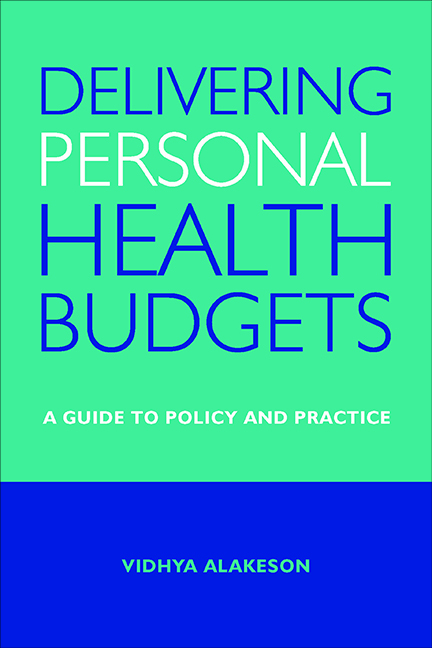Book contents
- Frontmatter
- Contents
- List of tables and figures
- Acknowledgements
- Prologue: Stephen’s story
- Introduction
- Section 1 Introducing personal health budgets
- Section 2 Implementing personal health budgets
- Section 3 Personal health budgets and organisational change in the NHS
- Conclusion
- Epilogue: Jonathan’s story
- References
- Index
seven - How to set a personal health budget
Published online by Cambridge University Press: 03 February 2022
- Frontmatter
- Contents
- List of tables and figures
- Acknowledgements
- Prologue: Stephen’s story
- Introduction
- Section 1 Introducing personal health budgets
- Section 2 Implementing personal health budgets
- Section 3 Personal health budgets and organisational change in the NHS
- Conclusion
- Epilogue: Jonathan’s story
- References
- Index
Summary
One of the five essential features of a PHB is that individuals should know upfront how much they have to spend in advance of starting to plan how best to meet their needs (DH, 2012e). This transparency makes care planning more effective, as discussed in the next chapter. Therefore, in order to implement PHBs, it is necessary to develop a process for allocating NHS resources to each eligible individual in a way that is fair between individuals and that ensures each person can meet their needs from within their allocated resources. It is important to remember that the allocation of resources to an individual is not the process that determines eligibility for a PHB. It simply determines the level of the PHB once an individual has been assessed as eligible. For example, in the context of NHS CHC, the decision support tool (DST) is the national eligibility framework. If individuals are eligible for CHC on the basis of their score on the DST, a separate allocation system subsequently determines the value of their PHB.
Findings from the national evaluation highlight a significant lack of clarity among participants about the level of their PHB and how it was determined. Three months after having signed up for a PHB, few participants knew how much was in their budget (Irvine et al, 2011), and even nine months into the pilot, a minority did not understand that a PHB was their own personalised allocation of funding. They did not know how much was in their budget, how much they had already spent, or even whether they had a budget in place (Davidson et al, 2012).
The evaluation results emphasise the need to get this stage of the PHB process right. Experience from personal budgets in social care cautions against making the allocation system too complicated. The first system that was developed in 2003 was one A4 page long. There are now local authorities with resource allocation systems that are 40 pages long, complex, restrictive of choice and costly (Duffy, 2011a). Keeping it simple is essential to the success of PHBs. After all, the initial budget amount around which an individual plans is only an indicative amount; it is a guide for care planning. It can be approximate in its accuracy rather than exact. A final budget amount is agreed at the point of final sign-off alongside the care plan.
- Type
- Chapter
- Information
- Delivering Personal Health BudgetsA Guide to Policy and Practice, pp. 81 - 90Publisher: Bristol University PressPrint publication year: 2014



